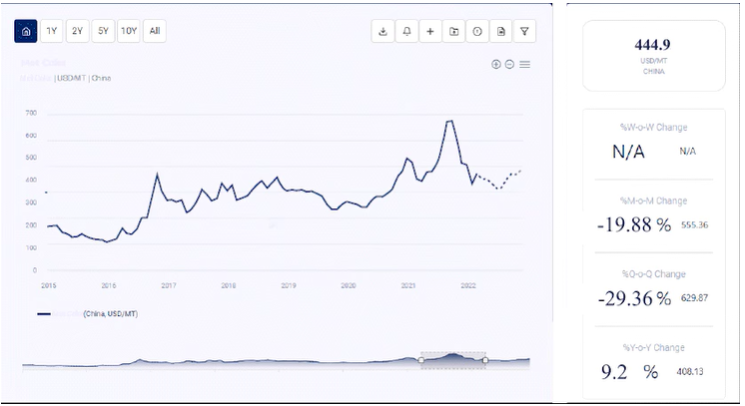Analyzing Price Trend of Chlorine: Influencing Factors

Chlorine, a versatile chemical used in various industries, including water treatment, chemical manufacturing, and pharmaceuticals, plays a vital role in numerous industrial processes. Understanding the price trends of chlorine is essential for businesses to anticipate costs, plan budgets, and make informed procurement decisions. In this article, we explore the factors influencing chlorine price trends and the dynamics shaping the market.
Factors Influencing Chlorine Price Trend Analysis:
- Raw Material Costs: The primary raw material for chlorine production is salt (sodium chloride), which is extracted from salt mines or obtained through the evaporation of seawater. Fluctuations in salt prices, influenced by factors such as mining costs, transportation expenses, and demand-supply dynamics, directly impact chlorine production costs. Changes in salt prices can have a significant effect on chlorine prices, as salt constitutes a substantial portion of production expenses.
- Energy Costs: Chlorine production is an energy-intensive process, typically involving the electrolysis of brine (sodium chloride solution) using electricity. Energy costs, including electricity prices and fuel prices for transportation and heating, significantly impact chlorine production expenses. Fluctuations in energy prices, influenced by factors such as fuel costs, electricity tariffs, and renewable energy adoption, can directly affect chlorine prices.
- Production Capacity and Demand: The balance between chlorine production capacity and market demand influences pricing trends. When production capacity exceeds demand, oversupply may lead to downward pressure on prices as manufacturers compete for market share. Conversely, when demand outstrips production capacity, shortages may occur, driving prices higher due to increased competition for available supply.
- Regulatory Environment: Regulatory requirements related to environmental standards, safety regulations, and chemical handling impact chlorine production costs. Compliance with regulations, including permits, licenses, and environmental assessments, may incur additional expenses for manufacturers. Changes in regulations, such as emissions limits or pollution control requirements, can affect production costs and pricing dynamics for chlorine.
- Market Competition: The presence of multiple suppliers and producers in the chlorine market creates competitive pressures that influence pricing trends. Intense competition among manufacturers may lead to price wars or aggressive pricing strategies to capture market share. Additionally, technological advancements, process innovations, and cost-saving measures adopted by competitors can impact pricing dynamics within the chlorine market.
Enquire For Regular Prices: https://www.procurementresource.com/resource-center/chlorine-price-trends/pricerequest
Market Dynamics and Outlook:
- Water Treatment Sector Demand: The water treatment industry is a major consumer of chlorine, utilizing it for disinfection purposes in municipal water treatment plants and swimming pools. Increasing demand for clean water, driven by population growth, urbanization, and industrialization, is expected to sustain demand for chlorine and support pricing trends in the long term.
- Chemical Manufacturing Applications: Chlorine is widely used in chemical manufacturing processes, including the production of PVC (polyvinyl chloride), solvents, and intermediates for various chemical compounds. Market dynamics in the chemical industry, including changes in demand for chemical products, shifts in manufacturing locations, and technological advancements, can influence chlorine demand and pricing trends.
- Pharmaceutical and Healthcare Use: Chlorine-based disinfectants are essential in healthcare settings for surface disinfection, medical equipment sterilization, and water purification. Growing awareness of infection control measures and the importance of disinfection in healthcare facilities may drive increased demand for chlorine-based products, impacting pricing trends in the healthcare segment.
- Global Economic Trends: Macroeconomic factors, such as GDP growth, inflation rates, and currency exchange rates, indirectly influence chlorine pricing trends. Economic downturns may lead to reduced industrial activity and demand for chlorine, exerting downward pressure on prices. Conversely, economic recovery and industrial expansion can stimulate demand and support pricing trends.
- Environmental Concerns and Regulations: Environmental regulations aimed at reducing chemical usage, minimizing waste generation, and promoting green alternatives may influence chlorine market dynamics. Increased focus on eco-friendly disinfection solutions, such as alternative disinfectants or chlorine-free water treatment methods, could impact traditional chlorine pricing models and market competitiveness.
Conclusion
In conclusion, the pricing trends of chlorine are influenced by a combination of factors, including raw material costs, energy prices, production capacity, demand dynamics, regulatory environment, market competition, and industry-specific trends. Understanding these factors and their interplay is essential for businesses to navigate the chlorine market effectively, anticipate pricing fluctuations, and make informed decisions regarding procurement, production, and pricing strategies. Moreover, staying abreast of evolving market dynamics, technological advancements, and regulatory developments is critical for businesses to adapt to changing market conditions and maintain competitiveness in the chlorine industry.










